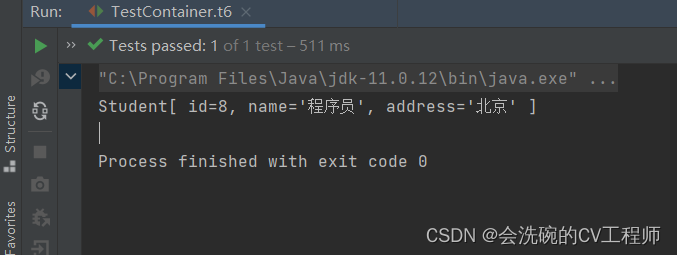Python 官方文档:入门教程 => 点击学习
目录一、什么是依赖注入二、依赖注入方式1. Setter注入2. 构造方法注入3. 自动注入三、依赖注入类型1. 注入bean类型2. 注入基本数据类型3. 注入List集合4. 注
依赖注入(Dependency Injection,简称DI),它是spring控制反转思想的具体实现。 控制反转将对象的创建交给了Spring,但是对象中可能会依赖其他对象。比如service类中要有dao类的属性,我们称service依赖于dao。之前需要手动注入属性值,代码如下:
public interface StudentDao {
Student findById(int id);
}
public class StudentDaoImpl implements StudentDao{
@Override
public Student findById(int id) {
// 模拟根据id查询学生
return new Student(1,"程序员","北京");
}
}
public class StudentService {
// service依赖dao,手动注入属性值,即手动维护依赖关系
private StudentDao studentDao = new StudentDaoImpl();
public Student findStudentById(int id){
return studentDao.findById(id);
}
}此时,当StudentService的想要使用StudentDao的另一个实现类如StudentDaoImpl2时,则需要修改Java源码,造成代码的可维护性降低。
而使用Spring框架后,Spring管理Service对象与Dao对象,此时它能够为Service对象注入依赖的Dao属性值。这就是Spring的依赖注入。简单来说,控制反转是创建对象,依赖注入是为对象的属性赋值
被注入类编写属性的setter方法
public void setStudentDao(StudentDao studentDao){
this.studentDao = studentDao;
}配置文件中,给需要注入属性值的 <bean> 中设置 <property>
<bean id="studentDao" class="com.itbaizhan.dao.StudentDaoImpl"> </bean>
<bean id="studentService" class="com.itbaizhan.service.StudentService">
<!--依赖注入-->
<!--name:对象的属性名 ref:容器中对象的id值-->
<property name="studentDao" ref="studentDao"></property>
</bean>测试
新增测试方法
// 测试依赖注入
@Test
public void t6(){
ApplicationContext ac = new ClassPathXmlApplicationContext("bean.xml");
StudentService service = (StudentService) ac.getBean("studentService");
System.out.println(service.findStudentById(8));
}运行结果

OK,确实成功测试到了
被注入类编写有参的构造方法
public StudentService(StudentDao studentDao){
this.studentDao = studentDao;
}给需要注入属性值的 <bean> 中设置 <constructor-arg>
<bean id="studentDao" class="com.itbaizhan.dao.StudentDaoImpl"></bean>
<bean id="studentService" class="com.itbaizhan.service.StudentService">
<!-- 依赖注入 -->
<!-- name:对象的属性名 ref:配置文件中注入对象的id值 -->
<constructor-arg name="studentDao" ref="studentDao"></constructor-arg>
</bean>测试结果:

OK,确实也是可以使用的
自动注入不需要在 <bean> 标签中添加其他标签注入属性值,而是自动从容器中找到相应的bean对象设置为属性值。
自动注入有两种配置方式:
autowire的取值如下:

DI支持注入bean类型、基本数据类型和字符串、List集合、Set集合、Map集合、Properties对象类型等,他们的写法如下:
准备注入属性的类
package com.example.service;
import com.example.dao.StudentDao;
import com.example.pojo.Student;
import java.util.List;
import java.util.Map;
import java.util.Properties;
import java.util.Set;
public class StudentService {
// service依赖dao,手动注入属性值,即手动维护依赖关系
//private StudentDao studentDao;
// bean属性
private StudentDao studentDao;
// 字符串类型
private String name;
// 基本数据类型
private int count;
// 字符串List集合
private List<String> students1;
// 对象类型List集合
private List<Student> nameList;
// 字符串类型Set集合
private Set<String> students2;
// 字符串类型Map集合
private Map<String, String> students3;
// 对象类型map集合
private Map<String,Student> studentMap;
// Properties类型
private Properties properties;
public StudentService(){}
public StudentService(StudentDao studentDao){
this.studentDao = studentDao;
}
public Student findStudentById(int id){
return studentDao.findById(id);
}
public void setStudentDao(StudentDao studentDao){
this.studentDao = studentDao;
}
public StudentDao getStudentDao() {
return studentDao;
}
public String getName() {
return name;
}
public void setName(String name) {
this.name = name;
}
public int getCount() {
return count;
}
public void setCount(int count) {
this.count = count;
}
public List<String> getStudents1() {
return students1;
}
public void setStudents1(List<String> students1) {
this.students1 = students1;
}
public Set<String> getStudents2() {
return students2;
}
public void setStudents2(Set<String> students2) {
this.students2 = students2;
}
public Map<String, String> getNames2() {
return students3;
}
public void setNames2(Map<String, Student> names2) {
this.studentMap = names2;
}
public Map<String, String> getStudents3() {
return students3;
}
public void setStudents3(Map<String, String> students3) {
this.students3 = students3;
}
public Properties getProperties() {
return properties;
}
public void setProperties(Properties properties) {
this.properties = properties;
}
public List<Student> getNameList() {
return nameList;
}
public void setNameList(List<Student> nameList) {
this.nameList = nameList;
}
@Override
public String toString() {
return "StudentService[ " +
"studentDao=" + studentDao +
", name='" + name + '\'' +
", count=" + count +
", students1=" + students1 +
", nameList=" + nameList +
", students2=" + students2 +
", students3=" + students3 +
", studentMap=" + studentMap +
", properties=" + properties +
" ]";
}
}准备测试方法
// 测试注入类型
@Test
public void t7(){
ApplicationContext ac = new ClassPathXmlApplicationContext("bean.xml");
StudentService service = (StudentService) ac.getBean("studentService");
System.out.println(service);
} <!-- 注入bean类型 -->
<bean id="studentDao" class="com.example.dao.StudentDaoImpl1"/>
<!-- 写法1 -->
<bean id="studentService" class="com.example.service.StudentService">
<property name="studentDao" ref="studentDao"/>
</bean>
<!-- 写法2 -->
<!--<bean id="studentService" class="com.example.service.StudentService">
<property name="studentDao">
<ref bean="studentDao"/>
</property>
</bean>--> <!-- 注入基本数据类型 -->
<!-- 写法一 name:属性名 value:属性值 -->
<property name="name" value="程序员"/>
<!-- 写法二 name:属性名 value:属性值-->
<property name="count">
<value>10</value>
</property> <!-- 注入List集合 -->
<!-- 简单的数据类型List集合 name:属性名 -->
<property name="students1" >
<list>
<value>上海</value>
<value>广州</value>
</list>
</property>
<!-- 对象类型的List集合 name:属性名 -->
<property name="nameList">
<list>
<bean class="com.example.pojo.Student">
<property name="id" value="1"/>
<property name="name" value="几何心凉"/>
<property name="address" value="北京"/>
</bean>
<bean class="com.example.pojo.Student">
<property name="id" value="2"/>
<property name="name" value="哈士奇"/>
<property name="address" value="上海"/>
</bean>
</list>
</property> <!-- 注入Set集合 -->
<property name="students2">
<set>
<value>深圳</value>
<value>北京</value>
</set>
</property> <!-- 注入Map集合 -->
<property name="students3">
<map>
<entry key="哈士奇" value="上海"/>
<entry key="几何心凉" value="北京"/>
</map>
</property>
<!-- 注入对象类型map类型 -->
<property name="names2">
<map>
<entry key="student1" value-ref="s1"/>
<entry key="student2" value-ref="s2"/>
</map>
</property> <bean id="s1" class="com.example.pojo.Student">
<property name="id" value="1"/>
<property name="name" value="几何心凉"/>
<property name="address" value="北京"/>
</bean>
<bean id="s2" class="com.example.pojo.Student">
<property name="id" value="2"/>
<property name="name" value="哈士奇"/>
<property name="address" value="上海"/>
</bean>上面是用到的bean对象
<!-- 注入properties -->
<property name="properties">
<props>
<prop key="配置1">值1</prop>
<prop key="配置2">值2</prop>
</props>
</property>运行测试方法测试一下

OK ,可以看到都是插入的了。
到此这篇关于详解Spring DI依赖注入的方式和类型的文章就介绍到这了,更多相关Spring DI依赖注入 内容请搜索编程网以前的文章或继续浏览下面的相关文章希望大家以后多多支持编程网!
--结束END--
本文标题: 详解SpringDI依赖注入的方式和类型
本文链接: https://lsjlt.com/news/212794.html(转载时请注明来源链接)
有问题或投稿请发送至: 邮箱/279061341@qq.com QQ/279061341
2024-03-01
2024-03-01
2024-03-01
2024-02-29
2024-02-29
2024-02-29
2024-02-29
2024-02-29
2024-02-29
2024-02-29
回答
回答
回答
回答
回答
回答
回答
回答
回答
回答
0